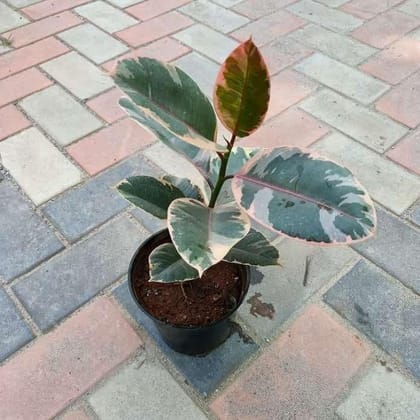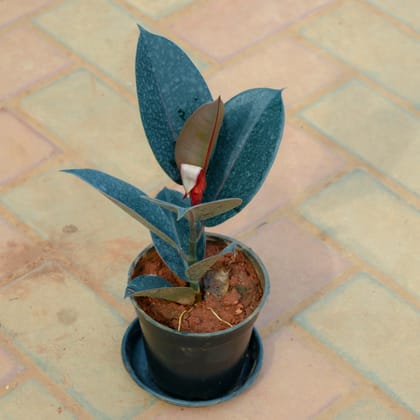- Plants
- Plants
- Home Decor Plants
- Home Decor Plants
- Pots
- Pots
- Soil & Add ons
- Soil & Add ons
- Seeds
- Seeds
- Tools
- Tools
- Decor
- Decor
- Gifting
- Gifting
- Bulk Gifting
- Bulk Gifting
- Gardening Kits
- Gardening Kits
- Outdoor Garden
- Outdoor Garden
- Others
- Others
- Sale
- Sale
- Best Selling Plants
- Best Selling Plants
Urvann is your one-stop online nursery for plants, planters, gardening accessories, and tools. Order fresh plants and get free home delivery on the next day!
ENUrvann is your one-stop online nursery for plants, planters, gardening accessories, and tools. Order fresh plants and get free home delivery on the next day!
https://www.urvann.com/s/6176774ef575bbd2b3331c8a/61db06dd744e78df7592f6d9/final-logo-01-1-_cropped-1.png https://www.urvann.com/s/6176774ef575bbd2b3331c8a/61db06dd744e78df7592f6d9/final-logo-01-1-_cropped-1.png +919599585773 [email protected]- Home
- Rubber Plant Collection
Rubber Plant Collection
Buy Rubber Plant Online in India
The rubber plant, scientifically known as Ficus elastica, is a popular houseplant cherished for its large, glossy leaves and elegant presence.
This tropical plant is native to Southeast Asia and belongs to the fig family. With its striking foliage and air-purifying properties, the rubber plant has become a favourite choice among plant enthusiasts.Urvann has made Rubber plant online shopping just a click away! Explore Rubber plant online collection at Urvann.
Benefits of Rubber Plants:
Air Purification: Rubber plants are excellent air purifiers, effectively removing toxins like formaldehyde and benzene from the air. Their large leaves act as natural filters, enhancing the quality of the indoor air and creating a healthier environment.Aesthetic Appeal: With their broad, dark green leaves and glossy appearance, rubber plants make a bold statement in any room. They add a touch of elegance and drama, making them ideal for both contemporary and traditional interior styles. The plant's upright growth habit and sturdy stems contribute to its visually pleasing presence.
Easy to Care For: Rubber plants are known for their durability and ability to thrive in a variety of conditions. They are relatively low-maintenance and can tolerate some neglect. This makes them suitable for beginners or those with busy lifestyles who still want to enjoy the benefits of indoor greenery.
Versatile Placement: Rubber plants are adaptable when it comes to placement. While they prefer bright, indirect light, they can tolerate lower light conditions, making them suitable for various rooms in your home or office. Just be sure to avoid placing them in direct sunlight, as it can scorch their leaves.
Care Tips for Rubber Plants:
Lighting: Rubber plants thrive in bright, indirect light. Place them near a window with filtered sunlight, ensuring they receive enough light to maintain their vibrant foliage. However, they can tolerate lower light conditions as well.Watering: Allow the soil to dry out slightly between waterings. Overwatering can lead to root rot, so it's best to err on the side of underwatering. Water the plant thoroughly, ensuring excess water drains out of the pot.
Humidity: Rubber plants appreciate moderate humidity levels. If the air in your home is dry, consider increasing humidity by placing the plant on a tray of water or using a humidifier.
Pruning: Regular pruning helps maintain the shape and size of the rubber plant. Trim any yellowing or damaged leaves using clean pruning shears to promote healthy growth.
Fertilization: Feed your rubber plant with a balanced, water-soluble fertilizer once a month during the growing season (spring and summer). Follow the package instructions for the proper dilution and application.
FAQ About Rubber Plants
1. How often should I water my rubber plant?
It's best to water your rubber plant when the top inch of soil feels dry. Avoid overwatering, as it can lead to root rot. Allow the soil to dry out between waterings, but don't let it become bone dry.
2. Can I place my rubber plant in direct sunlight?
While rubber plants prefer bright, indirect light, they can tolerate some direct sunlight. However, intense, direct sunlight can scorch their leaves. It's best to provide filtered or indirect light for optimal growth.
3. How fast does a rubber plant grow?
Rubber plants are relatively slow-growing, especially indoors. It can take several months or even years for a rubber plant to show significant growth. However, with proper care, they can eventually reach a considerable size.
4.Can I propagate my rubber plant?
Yes, rubber plants can be propagated through stem cuttings. Take a stem cutting with a few leaves and place it in water or a well-draining potting mix. Keep it warm and moist until roots develop, and then transplant it into a separate pot.
5. Why are the leaves of my rubber plant turning yellow?
Yellowing leaves on a rubber plant can indicate various issues, including overwatering, underwatering, or insufficient light. Assess your watering habits, ensure proper drainage, and adjust the plant's light exposure if necessary.
6. Can I keep my rubber plant outside?
Rubber plants are typically grown as indoor plants, but they can be placed outdoors in suitable climates. They thrive in warm, tropical conditions. However, they should be protected from direct sunlight and cold drafts.
7. Is the rubber plant toxic to pets?
Yes, rubber plants are considered toxic to cats and dogs. The plant's sap contains compounds that can cause irritation and digestive issues if ingested. Keep your rubber plant out of reach of pets or opt for pet-friendly plants if you have furry companions at home.
8. How often should I fertilize my rubber plant?
Fertilize your rubber plant once a month during the growing season (spring and summer) with a balanced houseplant fertilizer. Dilute the fertilizer according to the package instructions and apply it to moist soil.
9. Where can I get a Rubber Plant?
You can buy rubber plant online at Urvann. Urvann provides free next day delivery of fresh plants at your doorstep and offers easy returns.
Buy Rubber Plant Online in India
The rubber plant, scientifically known as Ficus elastica, is a popular houseplant cherished for its large, glossy leaves and elegant presence.
This tropical plant is native to Southeast Asia and belongs to the fig family. With its striking foliage and air-purifying properties, the rubber plant has become a favourite choice among plant enthusiasts.Urvann has made Rubber plant online shopping just a click away! Explore Rubber plant online collection at Urvann.
Benefits of Rubber Plants:
Air Purification: Rubber plants are excellent air purifiers, effectively removing toxins like formaldehyde and benzene from the air. Their large leaves act as natural filters, enhancing the quality of the indoor air and creating a healthier environment.Aesthetic Appeal: With their broad, dark green leaves and glossy appearance, rubber plants make a bold statement in any room. They add a touch of elegance and drama, making them ideal for both contemporary and traditional interior styles. The plant's upright growth habit and sturdy stems contribute to its visually pleasing presence.
Easy to Care For: Rubber plants are known for their durability and ability to thrive in a variety of conditions. They are relatively low-maintenance and can tolerate some neglect. This makes them suitable for beginners or those with busy lifestyles who still want to enjoy the benefits of indoor greenery.
Versatile Placement: Rubber plants are adaptable when it comes to placement. While they prefer bright, indirect light, they can tolerate lower light conditions, making them suitable for various rooms in your home or office. Just be sure to avoid placing them in direct sunlight, as it can scorch their leaves.
Care Tips for Rubber Plants:
Lighting: Rubber plants thrive in bright, indirect light. Place them near a window with filtered sunlight, ensuring they receive enough light to maintain their vibrant foliage. However, they can tolerate lower light conditions as well.Watering: Allow the soil to dry out slightly between waterings. Overwatering can lead to root rot, so it's best to err on the side of underwatering. Water the plant thoroughly, ensuring excess water drains out of the pot.
Humidity: Rubber plants appreciate moderate humidity levels. If the air in your home is dry, consider increasing humidity by placing the plant on a tray of water or using a humidifier.
Pruning: Regular pruning helps maintain the shape and size of the rubber plant. Trim any yellowing or damaged leaves using clean pruning shears to promote healthy growth.
Fertilization: Feed your rubber plant with a balanced, water-soluble fertilizer once a month during the growing season (spring and summer). Follow the package instructions for the proper dilution and application.
FAQ About Rubber Plants
1. How often should I water my rubber plant?
It's best to water your rubber plant when the top inch of soil feels dry. Avoid overwatering, as it can lead to root rot. Allow the soil to dry out between waterings, but don't let it become bone dry.
2. Can I place my rubber plant in direct sunlight?
While rubber plants prefer bright, indirect light, they can tolerate some direct sunlight. However, intense, direct sunlight can scorch their leaves. It's best to provide filtered or indirect light for optimal growth.
3. How fast does a rubber plant grow?
Rubber plants are relatively slow-growing, especially indoors. It can take several months or even years for a rubber plant to show significant growth. However, with proper care, they can eventually reach a considerable size.
4.Can I propagate my rubber plant?
Yes, rubber plants can be propagated through stem cuttings. Take a stem cutting with a few leaves and place it in water or a well-draining potting mix. Keep it warm and moist until roots develop, and then transplant it into a separate pot.
5. Why are the leaves of my rubber plant turning yellow?
Yellowing leaves on a rubber plant can indicate various issues, including overwatering, underwatering, or insufficient light. Assess your watering habits, ensure proper drainage, and adjust the plant's light exposure if necessary.
6. Can I keep my rubber plant outside?
Rubber plants are typically grown as indoor plants, but they can be placed outdoors in suitable climates. They thrive in warm, tropical conditions. However, they should be protected from direct sunlight and cold drafts.
7. Is the rubber plant toxic to pets?
Yes, rubber plants are considered toxic to cats and dogs. The plant's sap contains compounds that can cause irritation and digestive issues if ingested. Keep your rubber plant out of reach of pets or opt for pet-friendly plants if you have furry companions at home.
8. How often should I fertilize my rubber plant?
Fertilize your rubber plant once a month during the growing season (spring and summer) with a balanced houseplant fertilizer. Dilute the fertilizer according to the package instructions and apply it to moist soil.
9. Where can I get a Rubber Plant?
You can buy rubber plant online at Urvann. Urvann provides free next day delivery of fresh plants at your doorstep and offers easy returns.
Filter
- Sort ×
Urvann is your one-stop online nursery for plants, planters, gardening accessories, and tools. Order fresh plants and get free home delivery on the next day!
- Indoor Plants
- Low Maintenance Plants
- Flowering Plants
- Outdoor Foliage Plants
- Religious & Sacred Plants
- Air Purifying Plants
- Cactus & Succulents
- Good Luck Plants
- Plants by Location
- Plants of the Month
- Herbs-Medicinal & Vegetable Plants
- Fruit Plants
- Monsoon Plants
- Hanging Plants
- Potted Plants
- Bonsai Plants
- Special Plant Combos
- Bamboo Plant
- Pet Friendly Plants
- Plants to grow in Water
- Mosquito Repellent Plants
- Climbers & Creepers
Urvann India Private Limited
E-176
Delhi
Delhi 110060
IN
NEWSLETTER
Subscribe to get Email Updates!
Thanks for subscribe.
Your response has been recorded.












